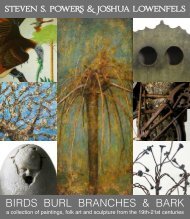MAN • BEAST • SPIRIT • WOMAN
Steven S. Powers presents, MAN • BEAST • SPIRIT • WOMAN. A collection of exceptional Folk Art & Americana assembled for exhibition and sale at Antiques In Manchester: The Collector's Fair. August 10-11, 2016. Sullivan Arena, St Anselm College, 100 St Anselm Dr. Manchester, NH 03102. Featuring works from The Marvill Collection and Americana from an important Midwestern Collection. MAN • BEAST • SPIRIT • WOMAN, explores examples of folk art that excompass these loose parameters. Some are straightforward, for example, The woman "Laundress" covers "Woman," (though in this context of broad labeling, it comes off as a one dimentional, misogynistic labeling). Other examples overlap, the cover image of the African-American limberjack, considers "Man," but is so powerful that it is imbued with, "Spirit" as well. The Woodlands, Ojibwa Mide'wiwin Figures covers, "Man, Woman and Spirit." The brownstone sculpture, "Men of the Pale Forest," explores "Man," but has elements of "Spirit and Beast." While the carved Gizzly Bear obviously represents, "Beast," its sensitive carving and remarkable surface gives her a "Spirit" as well.
Steven S. Powers presents, MAN • BEAST • SPIRIT • WOMAN. A collection of exceptional Folk Art & Americana assembled for exhibition and sale at Antiques In Manchester: The Collector's Fair. August 10-11, 2016. Sullivan Arena, St Anselm College, 100 St Anselm Dr. Manchester, NH 03102. Featuring works from The Marvill Collection and Americana from an important Midwestern Collection.
MAN • BEAST • SPIRIT • WOMAN, explores examples of folk art that excompass these loose parameters. Some are straightforward, for example, The woman "Laundress" covers "Woman," (though in this context of broad labeling, it comes off as a one dimentional, misogynistic labeling). Other examples overlap, the cover image of the African-American limberjack, considers "Man," but is so powerful that it is imbued with, "Spirit" as well. The Woodlands, Ojibwa Mide'wiwin Figures covers, "Man, Woman and Spirit." The brownstone sculpture, "Men of the Pale Forest," explores "Man," but has elements of "Spirit and Beast." While the carved Gizzly Bear obviously represents, "Beast," its sensitive carving and remarkable surface gives her a "Spirit" as well.
Create successful ePaper yourself
Turn your PDF publications into a flip-book with our unique Google optimized e-Paper software.
<strong>MAN</strong><br />
<strong>BEAST</strong><br />
S P I R I T<br />
W O M A N<br />
ANTIQUES IN <strong>MAN</strong>CHESTER 2016
S T E V E N S . P O W E R S<br />
<strong>MAN</strong><br />
<strong>BEAST</strong><br />
S P I R I T<br />
W O M A N<br />
Exceptional Folk Art & Americana assembled for exhibition and sale at<br />
Antiques In Manchester: The Collector's Fair. Featuring works from The<br />
Marvill Collection and Americana from an important Midwestern Collection.<br />
August 10-11, 2016.<br />
Sullivan Arena <strong>•</strong> St. Anselm College <strong>•</strong> Manchester, NH<br />
100 St. Anselm Dr, Manchester, NH 03102<br />
additional show information: antiquesinmanchester.com<br />
W O R K S O F<br />
A R T<br />
& a m e r i c a n a<br />
360 Court Street #28, Brooklyn, NY 11231 | 718.625.1715 or 917.518.0809 | stevenspowers.com | member: ADA
(previous and right) Men of the Pale Forest<br />
Brownstone<br />
Likely OH or PA origin<br />
Circa: 1890-1910<br />
Size: 8 1/2" (l) x 5" (w) x 6 1/2" (h)<br />
Provenance: Marvill Collection<br />
Though presented in the form of a utilitarian match strike, this object is a sophisticated<br />
sculpture that asks more questions than it answers. While the narrative of these forest dwelling<br />
men is unknown, it appears that some kinky psycho-sexual dream is playing out. A male figure<br />
sits on a stump, tongue panting and mouth agape, while another male nude stands astride a<br />
phallic tree root and peers around the tree holding a cat o' nine tails whip.<br />
Though authorship of this carving is undetermined, it has stylistic and thematic similarities to a<br />
small group of wood carvings that are also quite dark and sexualized. While, I am not making an<br />
attribution, it is worth exploring as a hypothesis.<br />
The artist of these aforementioned wood and polychrome carvings is also unknown, but it is<br />
believed that one artist created the group. The most well known of this group is entitled, “The<br />
Exorcism” (American Vernacular, page 178). The other known carvings are, “Prostitutes and<br />
Their Tricks,” and “It’s A Shame To Take The Money” (Sotheby’s, American Beauty: The<br />
American Folk Art Collection of Stephen and Petra Levin, Part I, lots 1407, 1409). If taken as a<br />
group (including the sculpture herein), the underlying theme revolves around sin and/or<br />
sexuality—on a progress bar they go from parlor humor to dark fetish.<br />
Aside from the overlapping themes, a number of stylistic similarities between the wood carvings<br />
and the stone carving can be noted. The first is body type—each figure is somewhat stocky, yet<br />
pillowy—with soft edges, not angular features. Their hands, eyes and hair are rendered alike<br />
(given the incidental variances that would occur between carving in stone and wood). Another is<br />
the way the artist executed the junction between the mouth and tree of the standing figure of the<br />
stone sculpture and the mouths between the kisses on the “Prostitutes” figures. The bases of<br />
each carving follows an irregular contour and not a proper rectangle, which is unusual and maybe<br />
telling of a relationship between the wood carvings and this most compelling stone sculpture.<br />
While this brownstone sculpture was conceived as a utilitarian object, a match strike, and the<br />
wood carvings are non-utilitarian art pieces, it reads just as much as a stand alone sculpture as<br />
the others.<br />
Additional research, insight and discussion is needed. In the meantime it stands strong and<br />
enigmatic on its own.
African-American Limberjack<br />
Carved wood, polychrome, mother-of-pearl, animal hair, iron, springs, linen<br />
Buffalo, NY<br />
Circa: 1860<br />
Size: 16" (l) x 17 1/2" (h)<br />
Provenance: Marvill Collection<br />
Illustrated and discussed in American Primitive, chapter plate for “Articulated<br />
Figures,” page 132, fig. 180.<br />
This large scale limberjack escapes the form and is powerfully rendered more as<br />
a fetish figure than an object of entertainment. It was likely created by an<br />
African-American street musician made for personal performance, not novelty. Its<br />
potent visage and presence can be compared to African nkisi or spirit figures<br />
with the arrangement of re-purposed and disparate materials from the applied<br />
animal hair, macramé, iron springs, mother-of-pearl eyes and the “offering up”<br />
posture.<br />
Its spring arms and jangly legs are animated by stepping up and down on the<br />
re-purposed iron band—as one would use a kick drum to keep time and rhythm.<br />
Dancing dolls or jig dolls have been used by street musicians and entertainers<br />
since at least the 16th century. During the 19th century, in America, the figures<br />
became a cottage craft and often depicted African-Americans as minstrel figures<br />
(in the exploitive genre). This figure escapes that ugly prejudice and presents a<br />
deeply personal and cultural work of art.<br />
The figure originated from, or around, Buffalo, NY. Buffalo is part of the Niagara<br />
Frontier and had long been a destination of free blacks. The first African-American<br />
settler arrived in 1792. By the mid 1800’s it had the 10th largest population<br />
of African-Americans and later became a stop along the Underground Railroad.
The Laundress<br />
Carved wood, polychrome, aluminum foil<br />
Circa: 1920<br />
Size: 14" (l) x 8 5/8" (h)<br />
Provenance: Hammer & Hammer; Marna<br />
Anderson; Marvill Collection<br />
Illustrated and discussed in American Primitive,<br />
page 67, fig. 85.<br />
Carved from hardwood, she stands well poised and<br />
neatly dressed with a robin’s egg blue dress, foil<br />
wrapped buttons and buckle, and smartly weaved<br />
bobbed hair.<br />
“The Laundress” is a unique expression of<br />
American folk art. She is indelible. When asked,<br />
“what objects do you most remember from the<br />
groundbreaking publication, American Primitive,”<br />
collectors often remark, “that towel woman!”
The Chambermaid<br />
Carved wood, polychrome<br />
Circa: 1920<br />
Size: 23" (h)<br />
Provenance: Marvill Collection<br />
This figure, as with the previous, represents an<br />
aspect of folk art we seldom see, women in the<br />
home or at work (in the home). Typically men<br />
carved women as muses, nudes, and objects of<br />
their affection. These women are shown in a<br />
straightforward, not overly sexualized manner.<br />
They are portraits of contemporary, employed<br />
women of the day.
Grizzly Bear<br />
Carved wood<br />
Iowa<br />
Circa: 1875<br />
Size: 10 7/8” (l) x 6 5/8” (w) x 6” (h)<br />
Large one piece carving of remarkable<br />
character and surface. The hefty bear is<br />
down on all fours with one hind leg<br />
coming through to the front.<br />
Surface is untouched, oxidized and<br />
maintains a “benchmark” dark, sensual<br />
patina.
(below) Dr. Gall Phrenology Burl Snuff Box<br />
Amboyna burl<br />
Circa: 1820<br />
Size: 3 1/4" (d) x 3/4" (h)<br />
A desirable, well defined Dr. Gall<br />
phrenology French pressed burl snuff box.<br />
Three skulls are depicted which are divided<br />
into twenty-seven numbered sections. The<br />
backside acts as a key and lists the<br />
corresponding twenty-seven emotions.<br />
Phrenology is a branch of pseudoscience in<br />
which the morphology of the skull is<br />
studied. Phrenologists believed the size and<br />
shape of the skull to be indicative of various<br />
emotional and character traits and of<br />
mental abilities. Dr. Franz Joseph Gall<br />
(1758-1828) is considered to be the founder<br />
of phrenology.<br />
(right) George Washington Phrenology Bust Inkwell<br />
Glass, iron<br />
Circa: 1860<br />
Size: 7" (l) x 7" (d) x 7" (h)<br />
A large, RARE Inkwell in the form of George<br />
Washington's head, which is idealized and is divided<br />
with phrenological numbered sections. The blackened<br />
cast iron base is sculpted with oak and laurel leaves and<br />
ivy—the leaves on the sides act as pen rests. The lid of<br />
the pen cup lid has an American eagle within a Federal<br />
shield—the underside reads: SEE WASHINGTON<br />
<strong>MAN</strong>UAL BY / JOHN HECKER, / N.Y. The front of the<br />
glass cup is lettered: WASHINGTON <strong>MAN</strong>UAL. The<br />
1866 manual was a guide to understanding the<br />
Washington phrenology bust. The sections that hold the<br />
pen cup is marked: PATENTED DEC 11, 1855.<br />
I have seen two others of this Washington inkwell in<br />
milk glass, but none in clear.
Emily Hanson (1840-1898)<br />
Spirit Drawing<br />
graphite on paperboard<br />
Circa: 1870<br />
Size: 28" (l) x 22" (h)<br />
A large-scale obsessive graphite drawing “Executed through spirit power, Miss Emily Hanson, instrument.<br />
Cumberland Mills, Maine.” Though (manipulated) spirit photographs are known, very few “spirit drawings”<br />
exist. Many of the tightly rendered florals have random faces hidden within. Also in the right center bottom, a<br />
village with houses and a park is illustrated. In addition to the drawing by Hanson, the whole surface is<br />
stippled on top of the drawing. The choice of flowers likely held meaning to Hanson, as there were books at<br />
the time that discussed the “language of flowers.”<br />
Spiritualism is a belief that spirits of the dead have both the ability and the interest to communicate with the<br />
living. Spiritualism developed and reached its peak in the mid-late 19th century.
The Marshalltown Menagerie (ninety-plus carvings)<br />
Marshalltown, Iowa<br />
Carved wood, polychrome, thorns, leaves.<br />
Circa: 1930<br />
Average size of animal: +/- 4" (l) x +/- 2 1/2" (h)<br />
The Marshalltown Menagerie is a group of ninety-plus extraordinary carvings<br />
created by an individual, unknown carver from Marshalltown, Iowa.<br />
Each animal is thoughtfully executed—with no repeats. Some have numerical<br />
tags, which likely, at some time, identified them as part of a key for display.<br />
According to family history, they were acquired directly from the artist by a Mr.<br />
Calvin White in lieu of payment. They remained within the White family for at<br />
least eighty years and are now just receiving their well deserved exposure.<br />
While most are carved from a single block of wood and then painted, some are<br />
finished with rose thorns, cactus thorns, sawdust, and vegetable fibers to add<br />
Spotted Hyena<br />
Marshalltown, Iowa<br />
Carved wood, polychrome<br />
Circa: 1930<br />
Size: 5 1/8" (l) x 2 1/2" (h)
additional detail. With<br />
the scale and number<br />
of carvings, one may<br />
think of the Noah’s<br />
Ark carvings from the<br />
late 19th and early<br />
20th centuries that<br />
were mass<br />
produced through a<br />
cottage industry—<br />
these are not those—<br />
each animal has a<br />
personality.<br />
Polar Bear<br />
Marshalltown, Iowa<br />
Carved wood, polychrome<br />
Circa: 1930<br />
Size: 5 1/8" (l) x 3" (h)<br />
From the polar bear<br />
with its lifted leg and<br />
“Pete the Pup” like<br />
black circled eyes; the<br />
beautifully posed and<br />
mottled spotted hyena; a Mongolian sheep with brown<br />
painted “wool,” achieved with applied sawdust and glue; to<br />
the dynamic<br />
seahorse with an elegant coiled tail, big doughy eyes and tens<br />
of applied spiky cactus thorns. There are groups of animals<br />
with horns and tusks, a group of dinosaurs, fish, and birds—<br />
all unique creations.<br />
One of the wildest carvings is a large sea creature (possibly<br />
the Loch Ness Monster given the circa 1930’s creation of these<br />
carvings). It has large orange fins and scalloped fins along its<br />
lanky back, and holds a smaller animal in its toothy jaws.<br />
The most complex of the carvings is a circus cart, which is<br />
composed of many elements. The fancifully painted cage on
the back of the cart<br />
contains a wild, spotted<br />
beast. Atop the<br />
cart sits a hurdygurdy<br />
monkey and a<br />
colorful slithering<br />
snake. A man sits at<br />
the reigns and ushers<br />
two giraffes who pull<br />
the wagon.<br />
The collection is<br />
offered as a group<br />
and will be displayed<br />
as such on a wall<br />
mounted zig-zagged<br />
ramp with all of the<br />
animals marching up<br />
to the circus cart.<br />
Mongolian Sheep(?)<br />
Marshalltown, Iowa<br />
Carved wood, polychrome,<br />
sawdust. glue<br />
Circa: 1930<br />
Size: 3 7/8" (l) x 3" (w)<br />
Seahorse<br />
Marshalltown, Iowa<br />
Carved wood, polychrome, cactus thorns<br />
Circa: 1930<br />
Size: 2 3/4" (l) x 6" (h)
Pulp Fiction: A Little Diddy About “Boots” and Evelyn<br />
Carved wood, polychrome, paper, ink, photograph<br />
York, PA<br />
Circa: 1925-1932<br />
Size: 16" (oah)<br />
A vignette comprised of two wood carvings, tattoo flash<br />
and a photograph of Charles William “Boots” Eyler<br />
(1908-1983) and Evelyn Marstellar (1912-2001) of<br />
York, Pennsylvania.<br />
The gun, realistically carved by Eyler is a Colt 45,<br />
model 1911 and is signed and dated, 1925, under the<br />
grips. The figure, also carved by Eyler, is a portrait of a<br />
twenty year old Evelyn dated 1932. She stands<br />
classically posed and confident while “Boots” carves<br />
her in all her glory.<br />
The photograph dated to the same year of the carving<br />
shows the young lovers laying on a flat rock—they were<br />
married the next year.
Ojibwa Mide'wiwin Figures<br />
Cottonwood, pigment<br />
Circa: 1840<br />
Size: 6" (oah)<br />
Provenance: W. E. Channing; Marvill Collection<br />
Related examples: Logan Museum of Anthropology, Albert Green<br />
Heath Collection, Beloit, WI, pair of like figures; The American<br />
Museum of Natural History, 50 / 5695 N, small female form medicine<br />
figure.<br />
These rare Woodlands figures were used by the Mide'wiwin or<br />
"Grand Medicine Society" of the Ojibwa Indians. As part of a<br />
ceremony for attracting a marriage partner, the figures would be tied<br />
face to face and mixed with “love powder” in a bag.<br />
Excerpted from: THE MIDĒ´WIWIN OR “GRAND MEDICINE<br />
SOCIETY” OF THE OJIBWA. By W. J. Hoffman.<br />
“This love powder is held in high esteem, and its composition is held<br />
a profound secret, to be transmitted only when a great fee is paid. It<br />
consists of the following ingredients: Vermilion; powdered snakeroot<br />
and a piece of ginseng cut from the bifurcation of the root, and<br />
powdered.”<br />
Eve<br />
Walter Tinna (Oswego, NY)<br />
Carved wood and polychrome<br />
Circa: 1940-50<br />
Size: 21 1/2" (h)
Eastern Great Lakes Woodlands (Iroquois) Ash Burl Bowl<br />
Ash burl<br />
Circa: 1800<br />
Size: 13 1/2" (l) x 12 1/8" (w) x 6 1/4" (h)<br />
Provenance: Private Midwestern Collection<br />
An exceptional example of a compact, well proportioned<br />
double handled Woodlands bowl.<br />
The bowl maintains a beautiful, nutty brown, surface and<br />
patina—burnished on the high-points and handles. The<br />
handles are masterfully resolved with smooth chamfered<br />
edges.<br />
Choice!
Klimt’s Kan Kollage<br />
Tin can lids, nails, brass tacks, wood tabletop<br />
Circa: 1930<br />
Size: 23" (l) x 31" (h)<br />
An assemblage of various tin can lids composed in<br />
an overlapping pattern, each meticulously nailed<br />
around the perimeter—like numbers on a clock<br />
face.<br />
The whole is reminiscent of Klimt’s work with<br />
silver and gold foils and reads as a macro-detail of<br />
some of his paintings.<br />
Framed and displayed as a painting.<br />
detail of Gustav Klimt’s<br />
Portrait Of Adele Bloch-Bauer I, 1907
(left) Deep Dentil Molded<br />
Cupboard<br />
New England<br />
Pine, butternut(?), red paint<br />
Circa: 1780<br />
Size: 24 5/8" (l) x 14 3/4" (w) x<br />
26 3/8" (h)<br />
Provenance: Private Midwestern<br />
Collection<br />
A bold and superb 18th century<br />
open display cupboard. First rate<br />
surface and condition.<br />
Rare New England Platform Lantern<br />
Pine, tin, glass, hinges<br />
Circa: 1780<br />
Size: 7 1/2" (l) x 8 1/4" (w) x 20" (h)<br />
Provenance: Private Midwestern Collection<br />
A remarkable, early American lighting device with a large<br />
conical, pierced tin chimney. The rabbet joined glazed box sits<br />
on extended legs which gives the whole a dramatic lift.
Unique Large Tiger Maple Charger / Circa: 1740 / Size: 14 1/4" (l) x 13 3/4" (w) x 2" (h) / Private Midwestern Collection
Exceptional Large Chestnut Charger / Circa: 1740 / Size: 14 3/4" (l) x 14 1/8" (w) x 2 1/4" (h) / Private Midwestern Collection
Folk Art Wantage Rod - Ezekiel Maxson (1789-1870)<br />
Hopkinton, RI<br />
Carved hickory<br />
Circa: 1823<br />
Size: 43 3/4" (oal)<br />
This is a neat piece! For the lover of instruments,<br />
brewery or vintner antiques...a wantage rod (gauge to<br />
determine volume within a cask or barrel). The<br />
hickory rod is inscribed with marks for BEER and<br />
WINE and with an elaborate conversion chart. The<br />
owner's name EZEKIAL MAXSON and DATE: 1823<br />
are also deeply inscribed.<br />
Maxson (1789-1870) turns up in census records for<br />
Hopkinton, RI and also served in the War of 1812.<br />
Dated 1769 Miniature Bootjack Chest with<br />
Reeded Edge<br />
Pine, paint, metal<br />
Circa: 1769<br />
Size: 14 1/8" (l) x 5 7/8" (w) x 7 3/4" (h)<br />
Provenance: Private Midwestern Collection<br />
A very fine miniature six board chest<br />
with an applied reeded molding and<br />
nicely formed bootjack ends. The two<br />
interior till covers date the piece in large<br />
separate numerals “6” “9.”<br />
Maintains original paint and surface.<br />
Original brass tip, pinned in place.
Knockers<br />
Brass<br />
Circa: 1900<br />
Size: 6" (d) x 4" (h)<br />
Large Coco de Mer<br />
Circa: late 19thC<br />
Size: 10" x 13"<br />
First rate example with a<br />
nice "thigh gap."
The Virgin of Sorrows<br />
Carved mahogany<br />
Circa: 16th-17thC<br />
Size: 13 3/4" (h) x 12 1/8" (w)<br />
An early Mexican panel carved in the<br />
transitional Indian-Christian (Aztec) or<br />
Tequitqui to Spanish Colonial period.
Eastern Great Lakes Woodlands (Iroquois) Ash Burl<br />
Bowl<br />
Ash burl<br />
Circa: 1700 (or earlier)<br />
Size: 13 1/2" (l) x 12 1/8" (w) x 6 1/4" (h)<br />
Provenance: Trotta-Bono, Peter Brams<br />
This Woodlands bowl has had its’ battle with the<br />
elements over time—however, it remains an<br />
evocative object.<br />
The large, sweeping, demilune cutout handle is<br />
diagnostic of early bowls and represents an eye of a<br />
manitou.<br />
The aged surface maintains a dry, complex patina.
A double sided Ray Johnson over a<br />
Xerox of an announcement of the<br />
“RAY JOHNSON<br />
CORRESPONDENCE SCHOOL<br />
MEETING SACRAMENTO STATE<br />
ART GALLERY 8:30 PM MARCH<br />
26-.” Dated 8.28.93. With “PLEASE<br />
SEND TO LEON TROTSY.”<br />
The other side with a screened<br />
image of bunny ears over a<br />
sideways illustrated bunny head,<br />
with the text “EAR DIARY, BY<br />
MONTE ZUMA.”<br />
The Soviet Marxist Trotsky was<br />
exiled to Mexico and was<br />
assassinated there—ergo Monte<br />
Zuma...Montezuma’s Revenge. And<br />
Trotsky kept a diary, and diary<br />
sounds like diarrhea... back to<br />
Montezuma’s Revenge.<br />
Archivally framed to be hung with<br />
either side displayed.<br />
Ray Johnson (1927-1995)<br />
Ear Diary, By Monte Zuma<br />
Silkscreen on paper, marker<br />
1993<br />
Size: 8 1/2" (w) x 11" (h)<br />
Provenance: Steven Wolf Fine Art, San Francisco,
CA.<br />
Side 2
Steven Powers (1968 -)<br />
Woodlands (Looking Into The Middle Distance)<br />
Oil on panel<br />
2016<br />
Size: 9" (h) x 12" (w)
Steven Powers (1968 -)<br />
Woodlands II (Looking Into The Middle Distance)<br />
Oil on panel<br />
2016<br />
Size: 11" (h) x 14" (w)
Bull Durham<br />
Cooperstown, NY<br />
Carved wood, polychrome<br />
Circa: 1920<br />
Size: 17" (l) x 12" (h)<br />
Large scale folk art carving with an extraordinary<br />
paint surface. Created by a shell-shocked WWI<br />
veteran, who found therapy in carving.
S T E V E N S . P O W E R S<br />
ANTIQUES IN <strong>MAN</strong>CHESTER 2016<br />
W O R K S O F<br />
A R T<br />
& a m e r i c a n a<br />
360 Court Street #28, Brooklyn, NY 11231 | 718.625.1715 or 917.518.0809 | stevenspowers.com | member: ADA


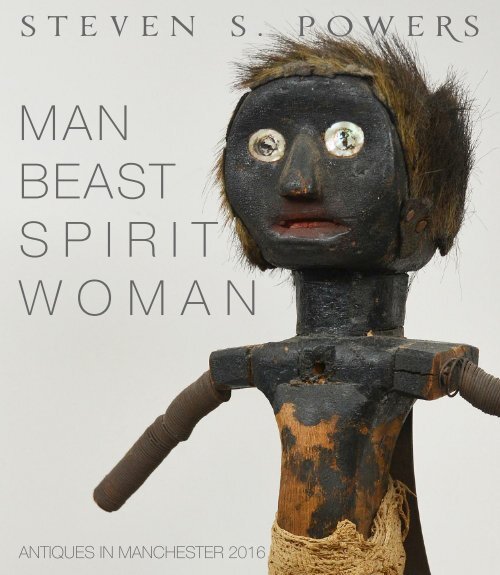

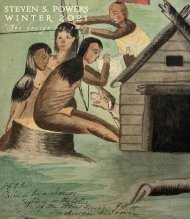
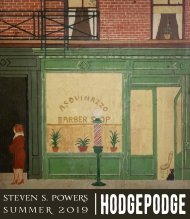
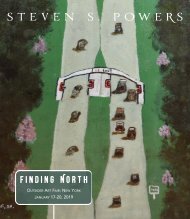

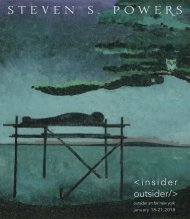

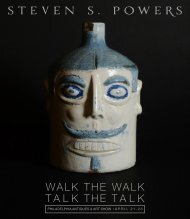
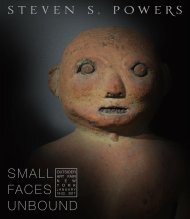
![NEEDLE • KNIFE • TORCH [&] BRUSH](https://img.yumpu.com/55309753/1/190x219/needle-o-knife-o-torch-brush.jpg?quality=85)
